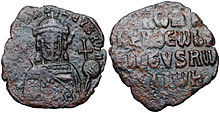Romanos I.

Romanos I. Lakapenos or Romanos Lekapenos ( Middle Greek Ρωμανὸς Αʹ Λεκαπηνός ; * around 870 in Lekapa in Cappadocia ; † June 15, 948 on Proti ) was a Byzantine emperor . He formally shared the throne with Constantine VII , but actually exercised sole power in the empire from 920 to 944.
Life
Romanos had made a career in the Byzantine fleet and rose to command of the entire fleet in 917. Around 919 the underage emperor Constantine VII is said to have turned to him and asked for assistance, because he feared that Domestikos Leon Phokas would take over power . Romanos married his daughter Helena Lakapene to Constantine on May 9, 919 and was appointed basile opator ("father of the emperor"), the imperial mother Zoe Karbonopsina was revoked and transferred to him.
Shortly thereafter, there was a rebellion by Leon Phokas, who described Romanos as a usurper and pretended to want to support the young emperor against his assumption of power. However, Romanos managed to convince the supporters of Leon Phocas of his legitimacy and was able to put down the uprising quickly.
Although Romanos was only officially appointed co-emperor in 920, he was able to assert himself as senior emperor and from then on practically alone to rule, while Constantine VII was subordinated in the order of priority and kept away from government affairs. In order to secure his position and to replace the Macedonian dynasty with his own family, he raised his eldest son Christophorus in 921 , his younger sons Stephanos and Constantine at the end of 923 and shortly afterwards his grandson Romanos as co-emperors. Apparently Romanos planned that Christophoros should follow him on the throne, because in diplomatic protocols he was now placed before Constantine, but he died in August 931. Subsequently, Constantine moved back to second place in the ranking.
Romanos tried domestically to control the accumulation of property, but had little success. He reformed some of the military districts ( subjects ), whereby the rebellions of Bardas Boilas in Chaldia (around 923/24) and of Basil Chalkocheir in Opsikion (around 930/32) may have played a role. Furthermore, various building measures by the emperor are documented, the most important of which is the construction of a new imperial palace with an adjoining court chapel, the Myrelaion . From an ecclesiastical point of view, it was important that in 920 he was able to end the schism between the supporters of the deposed Patriarch Euthymios and those of Nikolaos Mystikos .
In terms of foreign policy, Romanos made peace with the Bulgarians in 927 and defeated an attack by the Varangians on Constantinople in 941 . The peace in the west allowed him to concentrate his armed forces in the east, where General Johannes Kurkuas conquered the emirate of Malatya / Melitene and other areas after heavy fighting and made many of the princes of Armenia into Byzantine vassals. A particular triumph was the recovery of the so-called Mandylion from Edessa in 944.
Romanos was deposed in December 944 by his sons Stephan and Constantine, possibly even in agreement with Constantine VII. He spent the last years of his life as a monk on the island of Proti. In the further power struggle in Constantinople, Constantine was able to prevail, who made Romanos' illegitimate son Basileios Lakapenos his closest adviser. In the sources, Romanos is assessed ambiguously: for some he was considered a usurper, while other sources describe him as extremely positive.
literature
- Otto Kresten , Andreas E. Müller : Samtherrschaft, legitimation principle and imperial document title in Byzantium in the first half of the 10th century (= session reports Austrian Academy of Sciences, philosophical-historical class. Volume 630). Publishing house of the Austrian Academy of Sciences, Vienna 1995, ISBN 3-70-012226-8 .
- Ralph-Johannes Lilie , Claudia Ludwig, Thomas Pratsch, Beate Zielke, Harald Bichlmeier, Bettina Krönung, Daniel Föller, Alexander Beihammer , Günter Prinzing : Prosopography of the Middle Byzantine Period . 2nd department: (867-1025). Volume 5: Niketas (# 25702) - Sinapes (# 27088). Created after preliminary work by F. Winkelmann . Published by the Berlin-Brandenburg Academy of Sciences. De Gruyter, Berlin 2013, ISBN 978-3-11-016670-5 , pp. 578-594 No. 26833.
- Steven Runciman : The Emperor Romanus Lecapenus and His Reign. Cambridge University Press, Cambridge 1929 (ND 1963).
- Rudolf Naumann : The ancient rotunda at the Myrelaion and the palace of Romanos I. Lekapenos . In: Istanbuler Mitteilungen 50, 1966, pp. 424–439.
Web links
| predecessor | Office | successor |
|---|---|---|
| Constantine VII |
Emperor of Byzantium 920–944 |
Constantine VII |
| personal data | |
|---|---|
| SURNAME | Romanos I. |
| ALTERNATIVE NAMES | Romanos I. Lakapenos; Romanos I. Lekapenos; Ρωμανὸς A 'Λεκαπηνός (Middle Greek) |
| BRIEF DESCRIPTION | Admiral of the Byzantine Fleet; Emperor of Byzantium together with Constantine VII (920–944) |
| DATE OF BIRTH | around 870 |
| PLACE OF BIRTH | Lekapa , Cappadocia |
| DATE OF DEATH | June 15, 948 |
| Place of death | on Proti |
